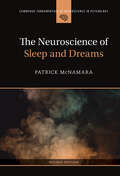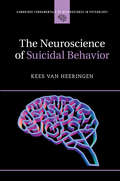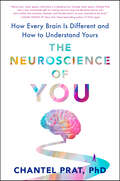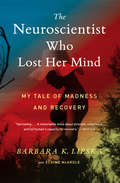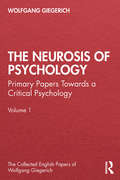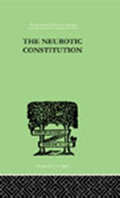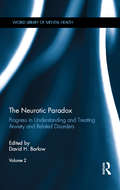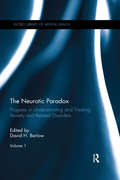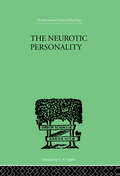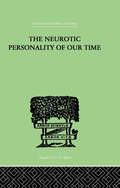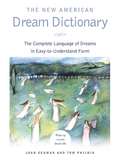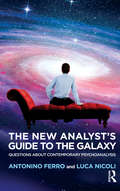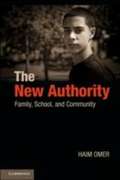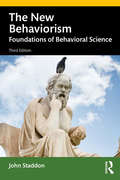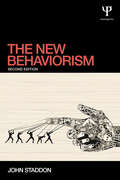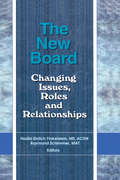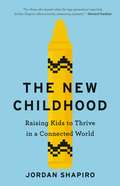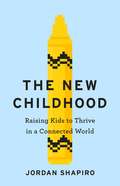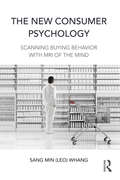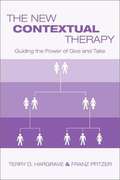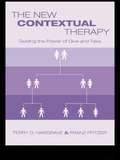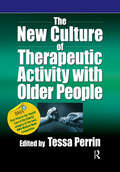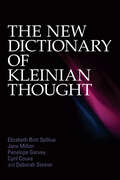- Table View
- List View
The Neuroscience of Sleep and Dreams (Cambridge Fundamentals of Neuroscience in Psychology)
by Patrick McNamaraThe Neuroscience of Sleep and Dreams provides comprehensive coverage of the basic neuroscience of both sleep and dreams for upper-level undergraduate and graduate students. It details new scientific discoveries, places those discoveries within evolutionary context, and links established findings with implications for sleep medicine. This second edition focuses on recent developments in the social nature of sleep and dreams. Coverage includes the neuroscience of all stages of sleep; the lifespan development of these sleep stages; the role of non-REM and REM sleep in health and mental health; comparative sleep; biological rhythms; sleep disorders; sleep memory; dream content; dream phenomenology, and dream functions. Students, scientists, and interested non-specialists will find this book accessible and informative.
The Neuroscience of Suicidal Behavior (Cambridge Fundamentals of Neuroscience in Psychology)
by Kees Van HeeringenNearly one million people take their own lives each year world-wide - however, contrary to popular belief, suicide can be prevented. While suicide is commonly thought to be an understandable reaction to severe stress, it is actually an abnormal reaction to regular situations. Something more than unbearable stress is needed to explain suicide, and neuroscience shows what this is, how it is caused and how it can be treated. Professor Kees van Heeringen describes findings from neuroscientific research on suicide, using various approaches from population genetics to brain imaging. Compelling evidence is reviewed that shows how and why genetic characteristics or early traumatic experiences may lead to a specific predisposition that makes people vulnerable to triggering life events. Neuroscientific studies are yielding results that provide insight into how the risk of suicide may develop; ultimately demonstrating how suicide can be prevented.
The Neuroscience of You: How Every Brain Is Different and How to Understand Yours
by Chantel PratFrom University of Washington professor Chantel Prat comes The Neuroscience of You, a rollicking adventure into the human brain that reveals the surprising truth about neuroscience, shifting our focus from what&’s average to an understanding of how every brain is different, exactly why our quirks are important, and what this means for each of us. With style and wit, Chantel Prat takes us on a tour of the meaningful ways that our brains are dissimilar from one another. Using real-world examples, along with take-them-yourself tests and quizzes, she shows you how to identify the strengths and weakness of your own brain, while learning what might be going on in the brains of those who are unlike you. With sections like &“Focus,&” &“Navigate,&” and &“Connect,&” The Neuroscience of You helps us see how brains that are engineered differently ultimately take diverse paths when it comes time to prioritize information, use what they&’ve learned from experience, relate to other people, and so much more. While other scientists focus on how &“the&” brain works &“on average,&” Prat argues that our obsession with commonalities has slowed our progress toward understanding the very things that make each of us unique and interesting. Her field-leading research, employing cutting-edge technology, reveals the truth: Complicated as it may be, no two brains are alike. And individual differences in brain functioning are as pervasive as they are fundamental to defining what &“normal&” looks like. Adages such as, &“I&’m not wired that way&” intuitively point to the fact that the brains we&’re piloting, educating, and parenting are wonderfully distinct, explaining a whole host of phenomena, from how easily a person might learn a second language in adulthood to whether someone feels curious or threatened when faced with new information. This book invites the reader to understand themselves and others by zooming in so close that we all look gray and squishy.
The Neuroscientist Who Lost Her Mind: My Tale of Madness and Recovery
by Barbara K. Lipska Elaine McArdleAs a deadly cancer spread inside her brain, leading neuroscientist Barbara Lipska was plunged into madness—only to miraculously survive with her memories intact. In the tradition of My Stroke of Insight and Brain on Fire, this powerful memoir recounts her ordeal and explains its unforgettable lessons about the brain and mind. In January 2015, Barbara Lipska—a leading expert on the neuroscience of mental illness—was diagnosed with melanoma that had spread to her brain. Within months, her frontal lobe, the seat of cognition, began shutting down. She descended into madness, exhibiting dementia- and schizophrenia-like symptoms that terrified her family and coworkers. But miraculously, just as her doctors figured out what was happening, the immunotherapy they had prescribed began to work. Just eight weeks after her nightmare began, Lipska returned to normal. With one difference: she remembered her brush with madness with exquisite clarity. In The Neuroscientist Who Lost Her Mind, Lipska describes her extraordinary ordeal and its lessons about the mind and brain. She explains how mental illness, brain injury, and age can change our behavior, personality, cognition, and memory. She tells what it is like to experience these changes firsthand. And she reveals what parts of us remain, even when so much else is gone.
The Neurosis Of Man: An Introduction to a Science of Human Behaviour (International Library Of Psychology Ser.)
by Burrow, TrigantFirst Published in 1999. Routledge is an imprint of Taylor & Francis, an informa company.
The Neurosis of Psychology: Primary Papers Towards a Critical Psychology, Volume 1 (The Collected English Papers of Wolfgang Giegerich)
by Wolfgang GiegerichThis first volume of The Collected English Papers of Wolfgang Giegerich takes its title from Giegerich's ground-breaking paper, On the Neurosis of Psychology, or The Third of the Two, originally published in Spring Journal in 1977. The third referred to in the title is psychology itself as the theory in which the two, patient and analyst, are contained as they engage with one another in the analytic process. By applying to psychology itself the ideas that analytical psychology draws upon when thinking about the patient, Giegerich establishes the basis for a psychology that defines itself as the discipline of interiority. Topics include Neumann's history of consciousness, Jung's thought of the self, the question of a Jungian identity, projection, the origin of psychology, and more.
The Neurotic Constitution: OUTLINES OF A COMPARATIVE INDIVIDUALISTIC PSYCHOLOGY and (Select Bibliographies Reprint Ser.)
by Adler, AlfredFirst Published in 1999. Routledge is an imprint of Taylor & Francis, an informa company.
The Neurotic Paradox, Vol 2: Progress in Understanding and Treating Anxiety and Related Disorders, Volume 2 (World Library of Mental Health)
by David H. BarlowThis collection of David H. Barlow‘s key papers are a testimony to the collaborative research that he engendered and directed with associates who now stand with him at the forefront of experimental psychopathology research and in the treatment of anxiety and related disorders. His research on the nature of anxiety and mood disorders resulted in new conceptualizations of etiology and classification. This research led new treatments for anxiety and related emotional disorders, most notably a new transdiagnostic psychological approach that has been positively evaluated and widely accepted. Clinical psychology will benefit from this collection of papers with connecting commentary.
The Neurotic Paradox, Volume 1: Progress in Understanding and Treating Anxiety and Related Disorders (World Library of Mental Health)
by David H. BarlowThis collection of David H. Barlow‘s key papers are a testimony to the collaborative research that he engendered and directed with associates who now stand with him at the forefront of experimental psychopathology research and in the treatment of anxiety and related disorders. His research on the nature of anxiety and mood disorders resulted in new conceptualizations of etiology and classification. This research led new treatments for anxiety and related emotional disorders, most notably a new transdiagnostic psychological approach that has been positively evaluated and widely accepted. Clinical psychology will benefit from this collection of papers with connecting commentary.
The Neurotic Personality (International Library Of Psychology Ser.)
by Gordon, R GFirst Published in 1999. Routledge is an imprint of Taylor & Francis, an informa company.
The Neurotic Personality Of Our Time (International Library Of Psychology Ser.)
by Horney, KarenTopics range from the neurotic need for affection, to guilt feelings and the quest for power, prestige and possession. First Published in 1999. Routledge is an imprint of Taylor & Francis, an informa company.
The New American Dream Dictionary: The Complete Language of Dreams in Easy-to-Understand Form
by Tom Philbin Joan SeamanDecoding dreams,A-to-Z. This dictionary provides an alphabetical listing of over 3,000 of the most common images and feelings that appear in dreams. With meanings taken from a variety of cultural traditions, as well as from such brilliant psychiatric minds as Carl Jung and Sigmund Freud, this easy-to-navigate A-to-Z guide is the key to interpreting the subconscious visions that visit during sleeping hours.
The New Analyst's Guide to the Galaxy: Questions about Contemporary Psychoanalysis
by Antonino FerroThis book touches upon many of the key areas of contemporary psychoanalysis: setting, technique, theory, as well as post-Bionian models and the 'Bionian Field Theory'. It is meant to be a self-defence handbook for new, usually young, analysts.
The New Authority
by Haim Omer Michal Herbsman Shoshana London SappirHaim Omer builds on his previous work to present a new model of authority for parents, teachers and community workers that is suitable for today's free and pluralistic societies. This new authority contrasts with traditional authority in that it emphasizes self-control and persistence over control of the child, a network of support over a strict hierarchy, taking mutual responsibility for escalations over holding the child solely responsible, patience over threats, non-violent resistance over physical force, and transparency over secrecy. In addition to a thorough discussion of the underlying theory, The New Authority presents a practical program for families, schools and communities. Dr Omer provides specific instructions to combat violence and risky behavior at home and in school, increase parent and teacher interest and support, and implement interventions that increase safety, improve atmosphere and generate community cohesiveness.
The New Authority
by Haim Omer Michal Herbsman Shoshana London SappirHaim Omer builds on his previous work to present a new model of authority for parents, teachers and community workers that is suitable for today's free and pluralistic societies. This new authority contrasts with traditional authority in that it emphasizes self-control and persistence over control of the child, a network of support over a strict hierarchy, taking mutual responsibility for escalations over holding the child solely responsible, patience over threats, non-violent resistance over physical force, and transparency over secrecy. In addition to a thorough discussion of the underlying theory, The New Authority presents a practical program for families, schools and communities. Dr Omer provides specific instructions to combat violence and risky behavior at home and in school, increase parent and teacher interest and support, and implement interventions that increase safety, improve atmosphere and generate community cohesiveness.
The New Behaviorism: Foundations of Behavioral Science
by John StaddonThis ground-breaking book presents a brief history of behaviorism, along with a critical analysis of radical behaviorism, its philosophy and its applications to social issues. This third edition is much expanded and includes a new chapter on experimental method as well as longer sections on the philosophy of behaviorism. It offers experimental and theoretical examples of a new approach to behavioral science. It provides an alternative philosophical and empirical foundation for a psychology that has rather lost its way. The mission of the book is to help steer experimental psychology away from its current undisciplined indulgence in "mental life" toward the core of science, which is an economical description of nature: parsimony, explain much with little. The elementary philosophical distinction between private and public events, even biology, evolution and animal psychology are all ignored by much contemporary cognitive psychology. The failings of radical behaviorism as well as a philosophically defective cognitive psychology point to the need for a new theoretical behaviorism, which can deal with problems such as "consciousness" that have been either ignored, evaded or muddled by existing approaches. This new behaviorism provides a unified framework for the science of behavior that can be applied both to the laboratory and to broader practical issues such as law and punishment, the health-care system, and teaching.
The New Behaviorism: Second Edition
by John StaddonThis groundbreaking book presents a brief history of behaviorism, the dominant movement in American psychology in the first half of the 20th Century. It then analyzes and criticizes radical behaviorism, as pioneered by B.F. Skinner, and its philosophy and applications to social issues. This second edition is a completely rewritten and much expanded version of the first edition, published nearly 15 years earlier. It surveys what changes have occurred within behaviorism and whether it has maintained its influence on experimental cognitive psychology or other fields. The mission of the book is to help steer experimental psychology away from its current undisciplined indulgence in "mental life" toward the core of science, which is an economical description of nature. The author argues that parsimony -- the elementary philosophical distinction between private and public events, even biology, evolution and animal psychology -- all are ignored by much contemporary cognitive psychology. The failings of radical behaviorism as well as a philosophically defective cognitive psychology point to the need for a new theoretical behaviorism, which can deal with problems such as "consciousness" that have been either ignored, evaded or muddled by existing approaches. This new behaviorism provides a unified framework for the science of behavior that can be applied both to the laboratory and to broader practical issues such as law and punishment, the health-care system, and teaching.
The New Board: Changing Issues, Roles and Relationships
by Mat Raymond Schimmer Nadia Ehrlich FinkelsteinMeet the challenge of coordinating effective board-staff teamwork! Using specific real-life examples and informed recommendations for board management, The New Board: Changing Issues, Roles and Relationships explains why and how to consider redesigning your board form and practice. The innovations suggested here, from minor adjustments to far-reaching reorganization, can help you find and keep board members, make board functioning more efficient, and help you comply with the new, stricter rules of managed care. The New Board informs the boards and staff of nonprofit residential service agencies about the nature of major contemporary challenges to board functioning. This innovative book offers an unusually diverse collection of contributors, including board members, executive staff, and academics. The resulting diversity of viewpoint produces a satisfying range of theoretical conversation and detailed description of actual practice. The New Board explores all the issues that affect boards in these days of rapid change: variations of board structures the pressures of managed care the increased complexity of service reduced board member availability the challenge of fund raising by modern boards contemporary considerations of legal liability of nonprofit boards The innovative ideas found in The New Board will help you and your nonprofit organization face the changes and challenges of the world of managed care. It is an essential resource for anyone interested in nonprofit organizations: CEOs and executive staff, academics and students in the field of nonprofit management, and board members themselves.
The New Childhood: Raising Kids to Thrive in a Connected World
by Jordan ShapiroA provocative look at the new, digital landscape of childhood and how to navigate it.In The New Childhood, Jordan Shapiro provides a hopeful counterpoint to the fearful hand-wringing that has come to define our narrative around children and technology. Drawing on groundbreaking research in economics, psychology, philosophy, and education, The New Childhood shows how technology is guiding humanity toward a bright future in which our children will be able to create new, better models of global citizenship, connection, and community.Shapiro offers concrete, practical advice on how to parent and educate children effectively in a connected world, and provides tools and techniques for using technology to engage with kids and help them learn and grow. He compares this moment in time to other great technological revolutions in humanity's past and presents entertaining micro-histories of cultural fixtures: the sandbox, finger painting, the family dinner, and more. But most importantly, The New Childhood paints a timely, inspiring and positive picture of today's children, recognizing that they are poised to create a progressive, diverse, meaningful, and hyper-connected world that today's adults can only barely imagine.
The New Childhood: Raising kids to thrive in a digitally connected world
by Jordan ShapiroIT'S TIME FOR A NEW APPROACH TO SCREEN TIME.Jordan Shapiro believes we need to rethink parental attitudes to technology. There's a damaging orthodoxy that presents screen-time as the ultimate modern parenting evil and the only acceptable response to it is restriction. Shapiro, psychologist, educational pioneer and father of two, draws on cutting-edge research in education, philosophy, neuroscience and psychology to show we've let fear and nostalgia stand in the way of our children's best interests. In his optimistic, inspiring and practical guide to the new, digital frontier of childhood, he reframes gaming, social media and smartphones to offer fresh, evidence-based advice on how to take a more progressive approach.*Winner of the Spirituality & Practice Book Award as one of the 50 Best Spiritual Books of 2018.*'Shapiro successfully transforms our worst fears about screen time into excitement about the potential for redesigning childhood around our latest technologies ... It's a necessary book that I urge you to read.' - The Telegraph'Shapiro knows what he's talking about ... Shapiro's arguments are compelling' - USA Today'a thought-provoking, bold read. As a father of two daughters at similar ages to Jordan's children (7 and 9), facing similar challenges and dilemmas, the book provided me with an inspiring and optimistic perspective that's rare in the current media landscape.' - Variety'Timely, essential, and thought-provoking, The New Childhood is the must-read parenting guide for raising 21st century, digitally driven kids. Instead of raising a white flag and giving in to social media and the Internet, Jordan Shapiro tells parents how to embrace technology, stay involved in their children's lives, and prepare them for their future. Read it! I promise you'll rethink your parenting. I couldn't put it down' - Michele Borba, EdD, author of UnSelfie: Why Empathetic Kids Succeed In Our All-About-Me World
The New Consumer Psychology: Scanning buying behavior with MRI of the mind
by Sang Min WhangThe term ‘consumption’ is generally thought of as process by which individuals purchase goods and services. The New Consumer Psychology attempts to explain consumption as a social behavior that satisfies individual values and desires. In modern society, individual needs are no longer determined solely by age or gender, but by the life values and desires that one pursues. This book uncovers people's subjective experiences of consumption in the capitalist society with interesting inside stories ranging from politics to designer handbags. <P><P>The book also provides valuable consumer insights into business and individuals by going beyond the limitations of population statistics and demonstrates Q-methodology is used to analyse consumers’ subjective responses. This book is an interesting take on how we should shift our focus from products to people and explains why identification and interpretations of different consumer groups are important in smart targeting. Its content will definitely inspire marketing strategies and market effectiveness.
The New Contextual Therapy: Guiding The Power Of Give And Take
by Terry D. Hargrave Franz PfitzerThrough detailing and examining the four interplaying dimensions of relationships, Contextual Theory gives therapists the ability to reshape human relationships and solve problems using the strengths of trust, fairness, and freedom. Not just a review of what came before, this brief clinical guide demystifies the Contextual Theory of family counseling for practitioners and students in language that is succinct and lucid in order to expose a whole new generation of therapists to this important approach to family therapy.
The New Contextual Therapy: Guiding the Power of Give and Take
by Terry D. Hargrave Franz PfitzerThrough detailing and examining the four interplaying dimensions of relationships, Contextual Theory gives therapists the ability to reshape human relationships and solve problems using the strengths of trust, fairness, and freedom. Not just a review of what came before, this brief clinical guide de-mystifies the Contextual Theory of family counseling for practitioners and students in language that is succinct and lucid in order to expose a whole new generation of therapists to this important approach to family therapy.
The New Culture of Therapeutic Activity with Older People (Speechmark Editions)
by Tessa PerrinOnce viewed as entertainment, activity provision is increasingly being seen as of therapeutic value and an integral part of quality care practice. This change has been so rapid and far-reaching that many staff teams have been left behind, attempting to address new culture requirements with old culture knowledge. This book clarifies and illuminates the changes that have been taking place in the field of activity provision over recent years, and offers a guideline to those who are endeavouring to catch up. The contents include: the difference between old culture and new culture thinking and practice; the new culture from the perspective of the politician, the manager, the care assistant, the activity provider, the researcher, the trainer, the community worker and the activity charity. Between them, the contributors bring a breadth of experience of the changing culture that spans more than three decades. The contributors include: Tessa Perrin; Rosemary Hurtley; Keena Millar Sylvie Silver; Paul Smith; Hazel May; Charlie Murphy; Vivienne Ratcliffe; Kenneth Hawes; Helen Crumpton; Carline Ryder-Jones, Wendy Ferguson Rebecca Colledge; Richard Mepham; Sally Knocker; Simon Labbett. This is a vital resource for all staff and management of care settings for older people.
The New Dictionary of Kleinian Thought
by Jane Milton Deborah Steiner Penelope Garvey Cyril Couve Elizabeth Bott SpilliusThe New Dictionary of Kleinian Thought provides a comprehensive and wholly accessible exposition of Kleinian ideas. Offering a thorough update of R.D. Hinshelwood’s highly acclaimed original, this book draws on the many developments in the field of Kleinian theory and practice since its publication. The book first addresses twelve major themes of Kleinian psychoanalytic thinking in scholarly essays organised both historically and thematically. Themes discussed include: unconscious phantasy, child analysis the paranoid schizoid and depressive positions, the oedipus complex projective identification, symbol formation. Following this, entries are listed alphabetically, allowing the reader to find out about a particular theme - from Karl Abraham to Whole Object - and to delve as lightly or as deeply as needed. As such this book will be essential reading for psychoanalysts, psychotherapists as well as all those with an interest in Kleinian thought.
